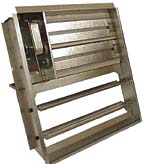The Term Defined
Economizer- The device is built in or retrofitted to rooftop equipment. It allows the unit to use outdoor air for cooling, provided the ambient air is below a certain temperature and the humidity is below a certain percentage. This type of cooling is often referred to as "free cooling" because it cools the building without the use of energy required to run a compressor.
Types Of Economizers
Dry Bulb Economizer- This economizer uses a sensor to determine if outdoor air is at or below a certain temperature, usually about 55 degrees F. If the outdoor air temperature is below setpoint and there is a call for cooling, an actuator opens a damper, allowing the outdoor air to mix with the return air to provide cooling. One problem with this type of system is the outside air could still be low enough in temperature to cool, yet contain too much humidity for creature comfort.Single Enthalpy Economizer - These use a sensor to determine if the outdoor air contains a low enough amount of humidity to use for cooling. Single enthalpy controls have been known to have problems. Over the years, elements used in these types of sensors sometimes break down, rendering the sensor inaccurate.

Integrated Differential Enthalpy Economizer - These are the same as the differential type except that now the controls can communicate with the indoor multi-stage thermostat. On a call for cooling, provided the temperature and enthalpy of the outdoor air are low enough, first-stage cooling would be the economizer. If outdoor air is not sufficient enough to cool the space, second-stage cooling would come on, initiating the system's compressor.
Demand-Control Ventilation
Economizers can be used to provide ventilation to a building. The demand-control system uses a carbon dioxide sensor located within the building to initiate operation. If carbon dioxide levels rise, and they will as more people enter the space, the economizer opens and allows fresh air to enter for proper ventilation.Benefits To Building Owners
One of the main reasons to use an economizer is to save money on electricity. The longer outside air can be used for cooling, the longer the compressor can remain off. Another benefit is the economizer actually can extend the life of the equipment - provided the system is maintained properly.Technician Opportunities
The economizer is one of the most often neglected components in an HVAC rooftop unit. It can be broken, and, as long as the damper is closed, the building owner may never know. Technicians who understand the economizer's operation can explain to the building owner how it can save them money in utility bills, creating a repair opportunity for themselves and their company.Over the years, economizer controls and sensors have gone from electromechanical to solid state. In some cases, hybrid variations grew out of rooftop units when various dampers, actuators, linkages, sensors, and controls were added over the economizer's life span. When a technician comes upon such a mix-match of components, it is in the customer's best interest to upgrade. Sensors lose their accuracy, dampers do not seal correctly, and linkages become sloppy - all costing the building owner in the form of higher utility bills.
The best source of operation and troubleshooting information still comes from the manufacturer. Consult The News' Web site (www.achrnews.com) and/or The News' HVACR Directory & Source Guide for manufacturer contact information.
David E. Rothacker is a member of the National Comfort Institute's Advisory Board and a National Comfort Team Founding Member. For questions or comments on Tech Basics, contact Rothacker at ewizaard@hotmail.com.
Publication date: 03/01/2004







